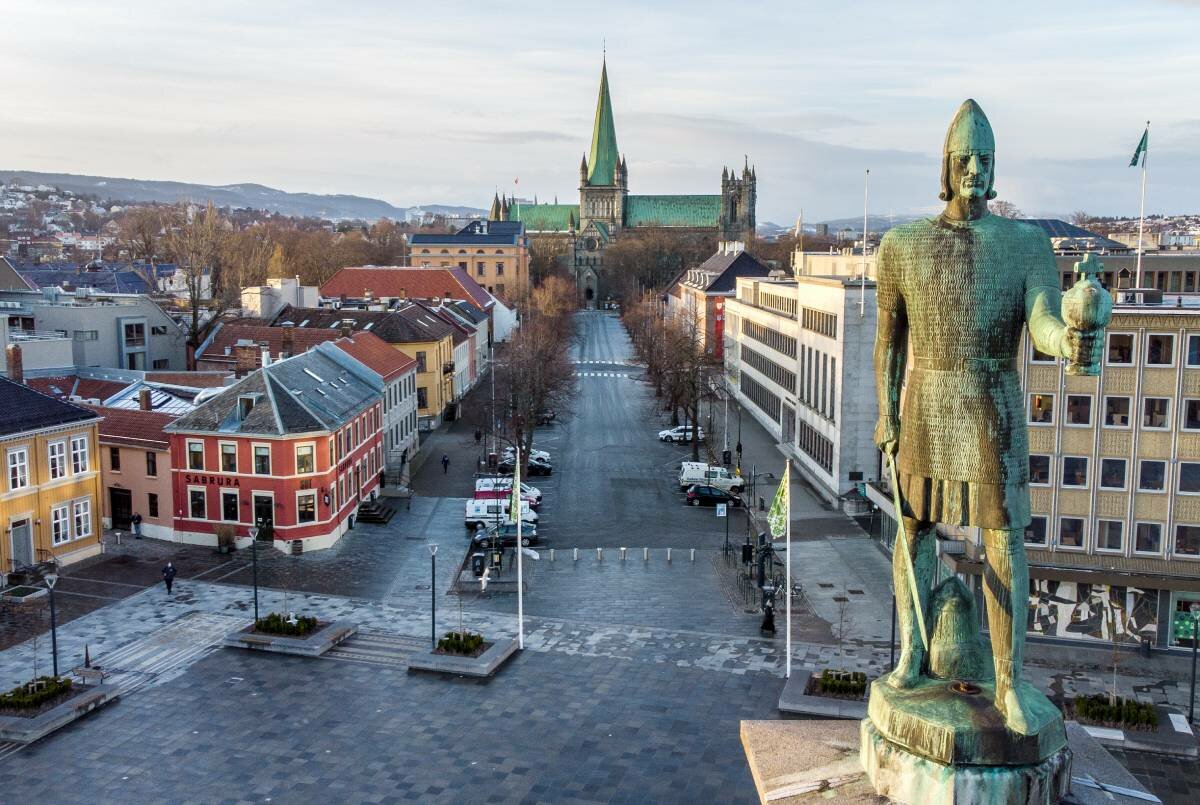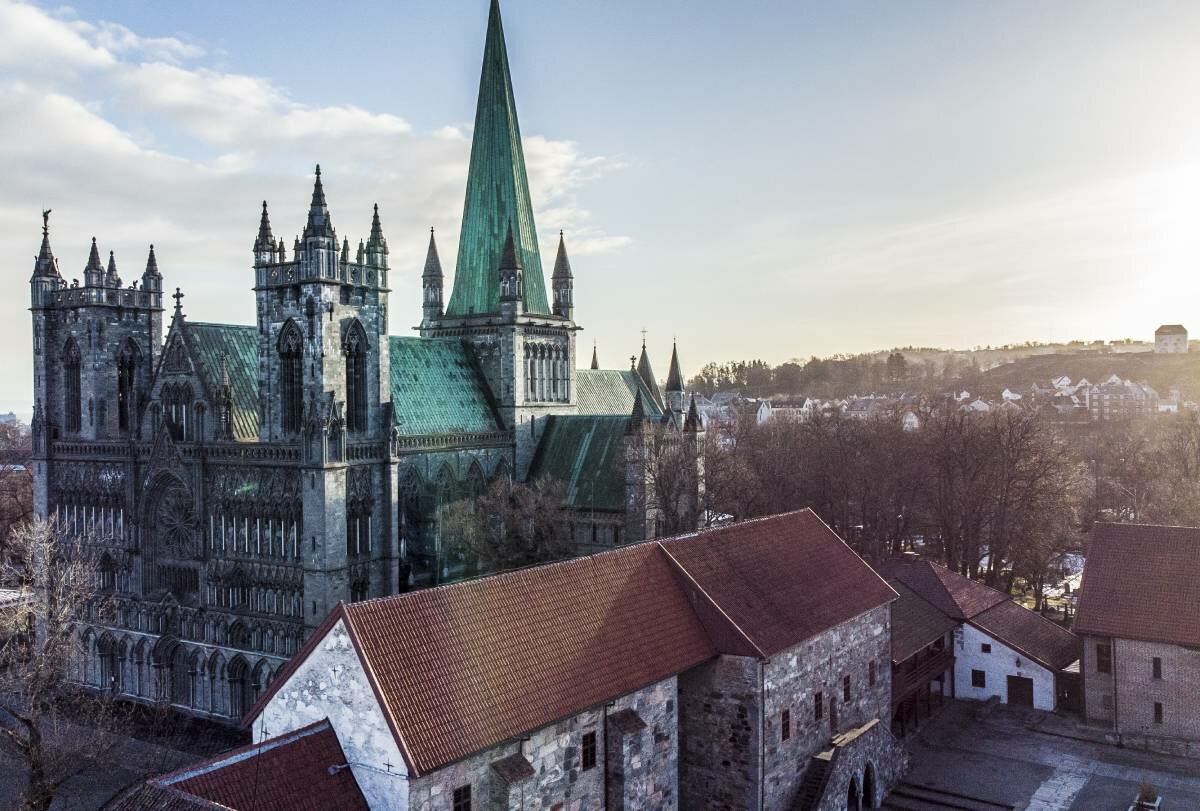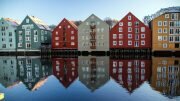The story behind the Norwegian city of Trondheim spans centuries and tells a tale of kings, fires, and religion.
Trondheim is Norway’s third-largest city, with its charming narrow streets and colorful wooden houses attracting crowds of eager guests each year. So, what is the story behind this characteristic place?
When it all started
Archeological finds show that people were present in the area thousands of years ago (at least), with graves discovered in Nirarneset in central Trondheim dating back to around 400 BC.
The city of Trondheim was, however, officially founded in the year 997. This means that it celebrated its 1000th anniversary in 1997!

There is little known about the founder of Trondheim, Olav Tryggvason. Researchers believe that he was king of parts of Norway around the years 995-999, at which point he likely met his death.
A statue of Tryggvason stands on a high pillar in the middle of Trondheim city center, honoring the founder of a city that today houses just over 200,000 people.
According to NTNU, the name «Trondheim» comes from the Norse word «Þróndheimr», where the first part is from «þrœndr» – «trønder», which probably means «the strong, fertile». The second part is from «heimr» – «residence».
The city was originally named Nidaros, which means “the city located at the mouth of the river Nid.” Nid refers to Nidelva, which is the river running through the city.
A city in growth
When the city was established as such in the year 997, the first houses were likely located next to the sea and connected to trade. In the 1000s, there were several streets as well as a bridge crossing the river.
Olav the Holy (in Norwegian: Olav den Hellige) is another king that had great influence over the city of Trondheim. After his death, he was declared a saint, and Nidaros Cathedral was built on his burial ground. It was begun around the year 1070 and finished around the year 1300.
See also: Churches in Norway are must-see sites. Here’s why
The towering church still stands today and was historically used as the site of coronation of the kings of Norway. This tradition, however, was last carried out in 1906 when King Haakon VII was crowned. Today, Nidaros Cathedral remains an essential symbol of the city of Trondheim – plus, it’s Norway’s largest church.

Trondheim became the archbishopric in 1152, and as a result, several monasteries were built in the area, including on the island of Munkholmen. From the end of the 13th century, almost 20 churches are known to have been built. Trondheim remained an ecclesiastical center until the Reformation in 1537.
After the Reformation, the city lost its status and its inhabitants experienced difficult times. In the 17th century, it experienced new growth as trade was on the rise. Raw materials from the region were exported, and a new settlement took place in Bakklandet.
A city on fire
Trondheim is a city full of wooden buildings and narrow streets, making it prone to city fires. The first known fire took place in 1219, while another in 1295 left most of the streets covered in ash.
Other noteworthy fires took place in 1481 and 1531. In 1531, the last Norwegian archbishop, Olav Engelbrektsson, tried to prevent the Danish influence on the country. This led to a Danish troop setting fire to the archbishop’s palace, and the flames quickly spread to the rest of the city.
After another great fire in 1681, a new plan was made for Trondheim by the king of Denmark and Norway Christian V, which included building wider streets to prevent the spread of flames. However, not all of the narrow streets were eradicated. As visitors to the city can attest, there are still many alleyways to stroll down across Trondheim.
Kristiansten Fortress and the city’s Old Town Bridge, both important structures in modern-day Trondheim, were built as part of Christian V’s town plan to rebuild the city.
Despite the prevention regulations imposed in 1681, Trondheim was hit by a new major fire in 1708, which destroyed most of the buildings between the main streets of Munkegata and Kjøpmannsgata.
A couple more fires followed in the 19th century, eventually leading to the construction of a brick wall throughout the city to contain any future outbreaks.
Newer history
Throughout the 18th century, the rich people of Trondheim built several large homes. One of these is Hornemansgården, which is located on Torvet and today boasts everything from a café and hair salon, to a legal office, and more.
Another noteworthy building from the 18th century is Stiftsgården, which is the official royal residence in Trondheim.
In the 19th century, industry became prevalent, with factories producing steamboats and locomotives, among other things. What are today Nedre Elvehavn and Solsiden, buzzing spots known for their shopping and gastronomy scenes, were previously industrial areas.
In 1964, Trondheim and four neighboring municipalities merged into Trondheim Municipality. Trondheim has since continued to grow today boasts a population of over 200,000 people, as well as countless students belonging to Norway’s largest university – the Norwegian University of Science and Technology (NTNU).
Source: #NorwayTodayTravel
Do you have a news tip for Norway Today? We want to hear it. Get in touch at [email protected]




Be the first to comment on "The fiery history of Trondheim, Norway’s third-largest city"